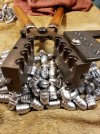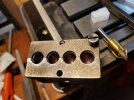The broken screw came right out. The Kroil soaking did the trick, plus it wasn't rusted in, just pulled in two, so when I touched off the bottom with a carbide end mill to make a flat spot to drill, it caught and spun right out.
I can't seem to leave anything alone and this turned into a monster, but I got it licked finally. The mould was loose on the pins, mainly the front alignment point. Bad ding on the lower right corner. Lube grooves rolled with big burrs on the front two cavities. Dressed the corner ding with a file, lightly chamfered the alignment holes, and tapped the front pin out a bit. Perfect lockup. Only problem is the blocks aren't square up and down. File and peen, got it close but the top isn't flat. Big sigh, fire up the casting furnace and run a few pours. Bullets hanging as expected in two cavities, bullets in the front aren't aligning vertically (right block low in front), rear cavities have grooves aligned but the blocks aren't even (left one high). To top it off, the bullets are .0015" out of round.
Cool the mould and study. The only fix I can come up with is re-bore the alignment holes and make oversized pins, so I press out the original pins, get the cavities very, very carefully trued and even using pin gauges and high magnification to vertically align the block halves with the original machining marks in the cavities, clamp firmly, and ream through the quarter-inch holes with a .465" chucking reamer. Then I rechamfered the female side, turned two new pins to mimic the .0015" interference fit of the originals, pressed them in, and verified the lockup. All looked good except the outside faces on all sides of the blocks are a little wonky.
Next, I set up the blocks to skim the tops square to the cavities, again using pin gauges and a test indicator to make certain the centerline of the cavities were dead-on vertical. Shim and tram, shim and tram, finally get it right. Skim the top of the blocks the bare minimum, cleaned up 95% of the surface by removing about .004" at the highest spot. Now with one flat, true reference surface, I spent couple minutes skimming the bottom and the ends flush and then broke all the edges with a file.
Next, the burrs in the cavities. I used a polished punch to clean up the sides of the lube grooves and then a centering punch shank tapped sideways to peen the curled corners of the lube groove forms back into place, eliminating the burs and closing the gap back up. Quick polish with a bronze brush wrapped in steel wool, degrease, and fire up the furnace again.
Now we're down to a few tenths out of round, vertical is good, bases are bee-uteeful now, all the grooves line up correctly, bullets shake out with no tapping, only problem is the back cavity wasn't bored deeply enough so it is almost a thousandth narrower at 90⁰ to the parting line than adjacent to it. I had cast several pours of reference bullets in sequence and rechecked them all, front, second, and third are all identical dimensions but the fourth (closest to handles) is narrow, so it isn't fixable by "Beagling" that end. I'm not going to lap it, Farmboy can do that or cast with the front three if the one skinny one is a bother. It probably won't make any difference for pistol bullets.
I did take a few photos as I went but this thing turned into a monster so I just focused on getting the work done.
The broken sprue plate screw is a 10-24 coarse thread with a flat head and smooth shank, almost exactly like a Tennessee mountain rifle lock nail. All the ones I have are fine thread.
Now, a question for you Saeco guys: how in the world is the sprue plate/left handle screw retained so it doesn't back out when swinging the plate? There's no shoulder, the sprue plate pivot hole and smooth hole through the block are clearance size for a #10 screw. No shoulder. No grub screw. What gives? Once I get the screw sorted out I can pack this thing up and get it sent back home.



